A list of the other articles in this series is given at the foot of this piece.
by Patrick Roefflaer
- Released: October 26, 1993
- Photographers: Ana Maria Vélez Wood (front) & Randee St. Nicholas (back)
- Liner Notes: Bob Dylan
- Art-Director: Nancy Donald
Many people have the impression that the photo on the cover of Dylan’s second acoustic album of the Nineties was carefully staged, like the one on Bringing It All Back Home.
What certainly adds to the impression is that Bob is dressed in character: a black coat, black gloves, a top hat and a walking stick (it’s actually an umbrella).
Then there’s a the setting: a green wall, a green table cloth and what looks like one of Dylan’s painting behind him. On the table there’s a blue bottle with a red candle…
The light coming from the right, with the singer face half hidden in the shadow. The photo is printed in a slight tilted angle, accentuated by the black line with the artists’ name and title of the album.
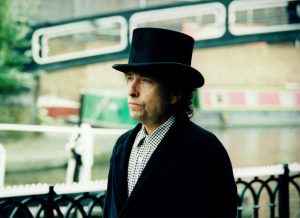 Certainly, Bob Dylan is dressed the same in the video Dave Stewart made for one of the songs from the album: ‘Blood in My Eyes’. But the circumstances of this photo session remained a mystery, until twenty years later.
Certainly, Bob Dylan is dressed the same in the video Dave Stewart made for one of the songs from the album: ‘Blood in My Eyes’. But the circumstances of this photo session remained a mystery, until twenty years later.
From 25th October to 8th November 2012, there was an exhibition in Battersea, London, called Blood in my Eyes. More than hundred photos were on display; all made by Ana Maria Vélez Wood on one day: July 21th, 1993. The day both the video and the photo were shot.
There was a catalogue available, in which the photographer and the director gave their comments on what happened that day. As much time had passed since then, they contradicted each other on some of the details. For example Dave Stewart and Ana Maria Wood differ about where and when the photographer got involved. Dave says he asked her about an hour into the shooting and she met them at Camden Lock, while Ana states that she met Dylan at The Church Studios, well before filming started…
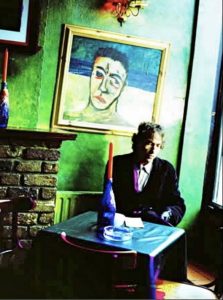 In this story, all of the quotes from Wood and Stewart were taken from the catalogue of the exhibition. Thanks to the great Dutch Dylan collector Arie de Reus, for helping me by providing scans from the catalogue. So here it goes:
In this story, all of the quotes from Wood and Stewart were taken from the catalogue of the exhibition. Thanks to the great Dutch Dylan collector Arie de Reus, for helping me by providing scans from the catalogue. So here it goes:
In the middle of the night, Dave Stewart and his wife Siobhan were alarmed by the phone ringing unexpectedly. When the former Eurythmic picked up the phone, he heard a man with an American accent saying something like: “Hi, this is Bob. I’m coming to London in a couple of hours to make a video. Would you help me?”
A sleepy Stewart soon realized that it was Bob Dylan who needed his help. He surely knew Dylan was in Europe at the time, as his Summer Tour had ended in Germany, four days before the call.
Although he hadn’t heard from Bob in a long time, the call didn’t come completely out of the blue, as Stewart has worked with Dylan before. In August 1985 he had been executive producer for the video clip of ‘Emotionally Yours’ and a few months later, Dylan even came to London to try out Eurythmics’ studio, The Church, in Crouch Hill, North London.
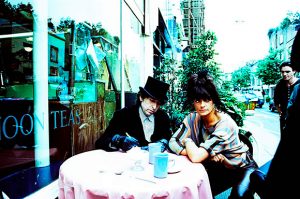 A few hours later, Bob Dylan meets Dave on his houseboat on the Regents Canal in Camden Town. There is not much of a plan and certainly no script for the video of ‘Blood In My Eyes’. So, they decide to do what Dylan usually does in this situation: go out in the street and see what happens.
A few hours later, Bob Dylan meets Dave on his houseboat on the Regents Canal in Camden Town. There is not much of a plan and certainly no script for the video of ‘Blood In My Eyes’. So, they decide to do what Dylan usually does in this situation: go out in the street and see what happens.
This is something he picked up from photographer Don Hunstein during the shoot for his second album, The Freewheelin’ Bob Dylan.
It must have been a strange sight for the shopping people on the streets that Wednesday morning: there is Bob Dylan, wearing a strange outfit and accompanied by Dave Stewart carrying two 8 mm cine cameras. No security.
Bob is in a very good mood, willing to give autographs and chatting to people young and old, as they stroll through town.
“I decided this should be documented as it became quite surreal”, explained Dave Stewart in August 2012. “We had been filming for about an hour. Then we had a 5 minute break and a cup of tea outside a cafe,
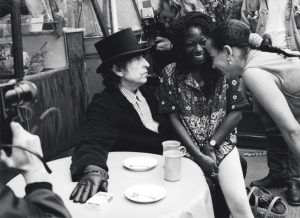
I seized the opportunity to call the one person I knew I could rely on and would drop everything and get to our location in record time, and she did!’
Stewart refers to Ana María Vélez Wood, a Colombian dancer, guitarist and singer he had worked with some time ago.
“Ana told me later she was a photographer,” Stewart recalled, “and actually came to the UK by winning a photographic contest in her home country Colombia. Over the years I got to know and love Ana’s sense of humour along with her lack or fear and ability to tackle anything from opening a Eurythmics show to cooking for 20 people at ten minutes’ notice!”
Ana remembers Dave sounded excited on the phone, “but in his characteristically laidback manner told me Bob Dylan had called him at 4am wanting him to film and direct a video for one of the tracks of his new forthcoming album ‘World Gone Wrong’, and he asked me if I could come along and shoot some stills.”
It appeared it was cheer luck she was in town: she had just returned from Colombia, where she had made a trip to the Amazon on her own.
“I still had the musty smell of the jungle and my photo equipment was in a plastic milk canteen I had used as a photo bag. This was a preventative measure so that my photo equipment would float in the event we overturned in any of the 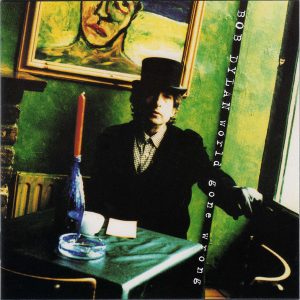 small canoe journeys through the small islands in the swamps of the Amazon River.
small canoe journeys through the small islands in the swamps of the Amazon River.
I was still in bed when Dave called so I got up quickly and transformed my photo bag into a ‘first world package’, took a taxi, got some film, and went straight to Dave’s recording studio [sic].”
“Ana immediately became invisible”, Dave adds, “and started shooting at a short distance aware of the fragility of the situation and the possibility that this could bring even more attention to a crowd that was growing by the minute. I introduced Ana to Bob and he immediately felt comfortable with her gentle way, so now we were three!”
“The first shots were done on the Lock”, writes Wood, “where curious onlookers started gathering slowly and Dave ( as only he can do), recruited them to be part of the video and escort Dylan across the bridges and paths, to perform juggling acts and support; at one point even recruiting a German Sheppard carrying a stick in his mouth who proudly paraded on a lead with Dylan. All along Dylan stood out underneath his top hat, but strangely, at the same time blended in perfectly with the surroundings.”
From Camdem Lock, they turn to the Camdem High Street, with their “small army of followers, in front of souvenir shops, zebra crossings, hair dressers and barber shops, slowly covering the length of High Street.”
Some scenes are required where Bob can mime some lines from the song.
“We stopped at café and this time Dylan took up position at a table by the sidewalk. As the waitress engaged in conversation with Dylan, a passing busker joined Dylan and Dave at the table .”
.”
As this proves to be too busy, they search for something quieter. They find a another small café, called Flukes Cradle, where Bob can sit inside, the light coming through the window. In some scenes you can see the people on the outside, looking in, while Dylan’s face is reflected in the glass. There’s a painting on the wall behind the singer, “propped up” on it’s left side by the mantelpiece.
In one of the photo’s in the exhibition, there’s a young man with an impressive quiff, sitting at the same table. In 2014, the guy is identified as Desmond van Oostrom. The Dutchman, was 21 years old at the time. He was shopping in London with a friend when he is approached by female photographer for a photo shoot. He is seated at a table in a cafe where, completely unexpectedly, as a table guest the legendary singer/songwriter Bob Dylan is next to him. Desmond is taken by surprise and Dylan – of course – is stoic. With a simple ‘thanks’ from Dylan, Desmond is thanked for the cooperation and he can go.
Although he leaves his address with the photographer, it’ll take more than 20 years before he receive the indisputable proof of his Bob Dylan moment.
So, in a way, the photo shoot wasn’t completely spontaneous after all.
After this scene, they return to Dave’s houseboat, where an impromptu film set is set up for more singing scenes, “with lights and everything in a space of not much more than a square meter”, as Wood remembers.
When all necessary filming is done, the small party heads to The Church Studios, to wind down. That was needed particularly for Dylan, explained Wood as he “Surely deserved his own space to shed the persona he adopted throughout the entire day’s shooting.”
When Dylan has changed, Dave hands the photographer an acoustic guitar to sing a few songs in Spanish and Portuguese for Dylan. The evening is wrapped up in a local Indian restaurant in Crouch End.
While Dylan heads off to his hotel, Dave and Ana Maria go “straight to Joe’s Basement, a 24-hour photo lab in Soho, to develop the film.
We asked for an express service, then walked the few blocks to Dave’s flat in Covent Garden. In less than an hour we returned to pick up the photographs.”
As Dylan has already flown to L.A. the next morning, Dave Stewart follows him the next day, to present him the photographs.
Bob picks one of Ana Maria’s photos from inside the restaurant for the cover of World Gone Wrong. Another photo, taken on the house boat is selected for the inside sleeve. On this Dylan is seen holding a glass of whiskey.
L’étranger
 As stated earlier, the painting in the café was not by Bob Dylan. It was already there. The extraordinary story of the painting was revealed in 1995 by it’s painter, Peter Gallager, in a letter published in Isis Magazine.
As stated earlier, the painting in the café was not by Bob Dylan. It was already there. The extraordinary story of the painting was revealed in 1995 by it’s painter, Peter Gallager, in a letter published in Isis Magazine.
“This story began in the early months of 1993, when, together with a friend of mine from the states, I trawled the art galleries of London, hoping to break into the closed-shop art exhibition circuit with a pile of heavy canvasses and portfolio of photographs and slides.
My heavily dour and moody portraits did not excite the optimistic decorative galleries, and we were shown the door many times before I could skate across the polished wooden floors to lay out my paintings for viewing. It seemed that our efforts were all to no avail, until we happened upon Flukes Cradle Cafe bar in Camden, who exhibit the works of many London artists. The manager decided to give me a chance and after two weeks of frantic preparation, my paintings were hanging shoulder to shoulder around this popular coffee bar.
After a steady start, I began to sell regularly and Flukes Cradle kept me on. Spring and summer passed and the autumn was drawing to a close when a bizarre chain of events occurred. This series of events began when I received a ‘phone call from a lady who, for the purpose of this essay will be known as Katherine. Katherine had called with a view to buying one of my paintings entitled “L’Etranger” which was hanging by the window at Flukes Cafe. Despite it’s catalogue price, I’d previously given the picture, as a present to Phil, a close friend, and I explained this to her. Curiously, she said, “I must have it!” and demanded my friends phone number. After I refused several times, she announced she was prepared to pay a lot of money for the painting. She said it no longer concerned me anymore, now that I had given it away. It interested me to know what she would offer my friend so I gave her his telephone number. It turned out that she was prepared to pay £500. Phil and I discussed this matter and decided to come to an arrangement, whereby we split the money between us.
On October 30th 1993 we met Katherine at Flukes Cradle Cafe bar, she was accompanied by a friend. I told the manager that I’d found a buyer for “L’Etranger”. He said that the painting would now be worth a lot of money. I didn’t understand what he meant, until he told me that Bob Dylan had sat beneath the painting and had been video’d by Dave Stewart, during the summer, with an album cover in mind. It was quite a surprise as you can imagine, especially since I’d been a regular patron there and nobody had mentioned it until now. Quite unbelievable really.
The painting itself shows a desperate and forlorn figure, on a beach having just committed a murder. His name Meursault, from Albert Camus’ famous (1942), novel, “L’Etranger”. The picture was “propped up” on it’s left side by the mantelpiece, in the front room of the café. The picture had fowled there when I had originally hung It, and to me it seemed that the mantelpiece “steadied” the painting from it’s dizzy and reeling subject matter. I was content to leave it tilting in such a way for this effect.
It’s always been my policy to be around personally to hand over my paintings to buyers and this was not going to be an exception. I like the feedback. The paintings mean a lot to me and I put my heart and soul into them. We spent a full hour with Katherine and her friend and I told her about Bob Dylan’s interest in the picture for his album cover.
It didn’t stir much of a response in her, she hardly twitched. I asked why she wanted the picture so badly. But equally, she hadn’t liked it when she first saw it, but had got to love it gradually, and she hoped to hang it above her bed and wake up to it every morning. She said it would bring her luck. Really? I thought. She seemed more intent on talking to my friend Phil, and Quantum Mechanics were mentioned several times between them. The only thing I know about Quantum Mechanics is that when a butterfly flaps it’s wings, there’ll be a blowin’ in the wind. Katherine was perhaps thinking of other things when she bought the picture.
A couple of weeks passed and my sister’s boyfriend rang me to say that he had just seen Bob Dylan’s CD ‘World Gone Wrong’ in Tower Records, London, and that my painting was indeed featured in the background. London Underground were now running large 5′ x 4′ posters of the album sleeve (the format of the posters was actually taller than that of the album cover, and in consequence displayed even more of my picture). There was a promotional video of the album’s single ‘Blood In My Eyes’ filmed in Camden, showing on national network T.V in the States. Full page magazine adverts. A number of people even likened my style of painting to that of Bob Dylan.
That was the good news, now for the bad. I had signed the painting in the bottom right hand corner, but unfortunately it was obscured by Dylan’s top hat. ‘Sony-Columbia’ had not approached me, and there was no mention of my name on the album credits. But for the manager of Flukes Cradle making a cursory remark two weeks previous, I might have come face to face with my painting on London Underground, late at night, alone on a platform, in a drunken stupor. What would you have done? Jump! This is the misery line.
Like all good euphoric attacks there is an equally disabling depression just around the comer. Could not the record company have said something; asked permission. My brother suggested I ring Sony Columbia in London. I had started off in Camus and ended up in a Kafka novel. Look for a decision maker. Find the responsible person forget it! I got a music solicitor to find out why nobody asked me for license to use the painting. I still had copyright, and it was my intellectual property. Why no credit? What followed was, almost a year of knee bending, twitching swordplay, legal bluff. Noise of wind, in impotent gusts wafting to and fro across the Atlantic. More blowin in the wind. Gastro Enteritis I call it.
It was in February 1994 that Sony Columbia informed me that Bob Dylan had bought the painting “with the specific objective of avoiding any further difficulties.” In March, Sony’s New York law dept. continued with a letter. It followed that; “Jeff Rosen (from Dylan’s New York office), had asked one of Dave Stewart’s employees to purchase the painting, so he would have rights to it when the album was released. Two of Dave Stewart’s employees located the (Camden) restaurant but were told that the painting had been sold to Katherine.” Within 48 hours they met Katherine and had bought the painting from her for £2,500. Well, she had said it would bring her good luck! £2,000 profit in two days. I call that incredible good luck!!
Strange to say that as a sixteen year old I used to play tennis with a Bob Dylan fan. I had little interest or awareness of his hero’s songs until one day he rammed Dylan’s lyrics down my throat and told me I must be stupid if I didn’t understand him. I just felt hurt. I have never listened to a Bob Dylan album since that day, apart from ‘World Gone Wrong’ It’s all the more poignant now. I did however, like the album.
As a painter and musician in my own right, it’s been a strange year. Bob Dylan on one side, me on the other and a minefield of legal jargon between us. I still don’t understand him. Has the World Gone Wrong? To avoid further calamities I accepted the painting back from the Dylan camp and they agreed to a credit on future printings of the album. Sony paid my legal fees and suggested I could make a good price from the painting, because of its association with Dylan.”
The photo on the back sleeve is made by celebrity photographer-designer Randee St. Nicholas. She’s the ex-wife of Steppenwolf singer Nick St. Nicholas – hence the name. The photographer, living in Los Angeles is specialized in photographing musicians and perhaps most famous for her Prince book 21 Nights (2008). Other photos from the Dylan shoot were used as late as 1997 on the single ‘Dreaming of You’.
Because Dylan had been criticized for being very vague about the authors on his previous acoustic cover record, Good As I Been To You, he wrote extensive (and excellent) liner notes, titled About The Songs (what they’re about). This filled the rest of the vinyl album’s back sleeve.
Previously published…
- The art work of Street Legal and the secret cover location
- The story of the art work on Bringing it All Back Home
- The untold story of the artwork on Bob Dylan’s Greatest Hits
- The Sleeve Art of Bob Dylan’s album: “Bob Dylan”
- The Sleeve Art of Bob Dylan’s Album: Slow Train Coming
- The Freewheelin’ Bob Dylan – the untold story of the artwork of the album
- Times they are a changin’: the album artwork
- The art work on Bob Dylan’s albums: The Basement Tapes
- The source of the artwork of “Another side of Bob Dylan”
- The art work on Bob Dylan’s “Infidels”: what’s in a name?
- The art work of Nashville Skyline
- Absolute Exclusive: Empire Burlesque and Biograph artwork
- The artwork to Knocked Out Loaded
- The Art Work of the Traveling Wilburys Vol 1 (guest visitor, Michael Palin)
- The untold story of the artwork on Bob Dylan’s Greatest Hits
- The Sleeve Art of Bob Dylan’s album: “Bob Dylan”
- The Sleeve Art of Bob Dylan’s Album: Slow Train Coming
- The Freewheelin’ Bob Dylan – the untold story of the artwork of the album
- Times they are a changin’: the album artwork
- The art work on Bob Dylan’s albums: The Basement Tapes
- The source of the artwork of “Another side of Bob Dylan”
- The art work on Bob Dylan’s “Infidels”: what’s in a name?
- The art work of Nashville Skyline
- Absolute Exclusive: Empire Burlesque and Biograph artwork
- The artwork to Knocked Out Loaded
- The Art Work of the Traveling Wilburys Vol 1 (guest visitor, Michael Palin)


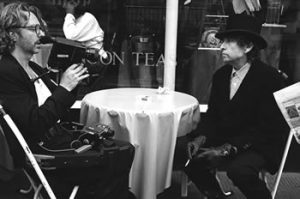

Very interesting
Thanks Larry.
Just stumbled across this and it’s so interesting to me as I had an exhibition of my photography in the same room at the front of Fluke’s Cradle just three years earlier. I sold eight pictures on opening night and had a review in the Camden New Journal. I spent a lot of time drinking coffee in that room waiting for prospective buyers and I remember the green walls well. I have some pictures in storage of the launch party (mostly Guardian friends) and I’ll dredge them up. Great song by Bob.
It’s a shame the Flukes Cradle, venue is no longer in existence. It was an inspirational place to sit and people watch around Dylan’s time in Camden Town.
I conjured up quite a few would-be characters for my novels in that place, and so, it’s no co-incidence that my latest novel, a psychological thriller, ‘Fluke’s Cradle’ is named after the place.